
Herzog & de Meuron Basel Ltd. is a Swiss architecture firm headquartered in Basel (Switzerland), founded by Jacques Herzog and Pierre de Meuron.
Ogata Kōrin was a Japanese landscape illustrator, lacquerer, painter, and textile designer of the Rinpa School.
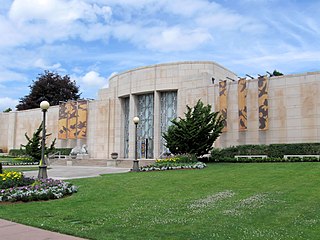
The Seattle Asian Art Museum is a museum of Asian art at Volunteer Park in the Capitol Hill neighborhood of Seattle, Washington, United States. Part of the Seattle Art Museum, the SAAM exhibits historic and contemporary artworks from China, Korea, Japan, India, the Himalayas, and other Southeast Asian countries. It also features an education center, conservation center, and library. The museum is located in the 1933 Art Deco building which was originally home to the Seattle Art Museum's main collection. In 1991 the main collection moved to a newly constructed Seattle Art Museum building in the downtown area. The Seattle Asian Art Museum opened in 1994.

Abinadi Meza is an American visual artist, sound artist, and experimental filmmaker whose works focus on transformation, spatial politics, and poetics. His films, sound art, performances, and installations have been presented at Anthology Film Archives, New York; Brooklyn Film Festival, New York; MAXXI, Rome; Matadero Madrid; Cinemateca Nacional del Ecuador, Quito; Cinemateca do Museu de Arte Moderna, Rio de Janeiro; SF Cinematheque, San Francisco; Walker Art Center, Minneapolis; American Academy in Rome; Irish Museum of Modern Art, Dublin; Blaffer Art Museum, Houston; FACT, Liverpool; La Casa Encendida, Madrid; Minneapolis Institute of Arts; Mexic-Arte Museum, Austin; New Orleans Film Festival; La Casa Encendida, Madrid, and Lisbon Architecture Triennale. Meza primarily uses ephemeral, precarious, site-specific and salvaged materials in his work. As a young artist Meza studied Butoh with teachers from Japan, Europe and South America. Later he earned a Bachelor of Arts degree from the University of Northern Iowa, (1999); a Master of Fine Arts degree from the University of Minnesota (2004); and a Master of Architecture degree from SCI-Arc, the Southern California Institute of Architecture(2009). Meza's family background is Native American, Portuguese, Moroccan, and Russian.
Tony Oursler is an American multimedia and installation artist married to Jacqueline Humphries. He completed a Bachelor of Fine Arts at the California Institute for the Arts, Valencia, California, in 1979. His art covers a range of mediums, working with video, sculpture, installation, performance, and painting. He lives and works in New York City.
Matej Andraz Vogrinčič is a Slovenian artist. He has been creating site-specific work in urban and natural environments since the early 1990s. He has built an international reputation by creating installations specific to local places, traditions, and histories – filling the most ordinary or neglected places with even more ordinary objects. With all his work, Vogrinčič starts with the space but always leaves room to alter and develop the idea in the process. His projects rely on a direct connection with the local community, including clothing and toy car donations.

Hon'ami Kōetsu was a Japanese calligrapher, craftsman, lacquerer, potter, landscape gardener, connoisseur of swords and a devotee of the tea ceremony. His works are generally considered to have inspired the founding of the Rinpa school of painting.
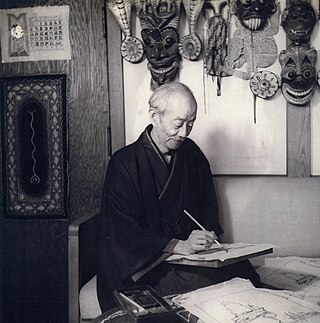
Hiroshi Yoshida was a 20th-century Japanese painter and woodblock printmaker. Along with Hasui Kawase, he is regarded as one of the greatest artists of the shin-hanga style, and is noted especially for his landscape prints. Yoshida made numerous trips around the world, with the aim of getting to know different artistic expressions and making works of different landscapes. He traveled widely, and was particularly known for his images of non-Japanese subjects done in traditional Japanese woodblock style, including the Taj Mahal, the Swiss Alps, the Grand Canyon, and other National Parks in the United States.
Miao Xiaochun is an artist and photographer based in Beijing.
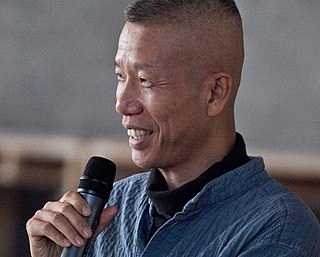
Cai Guo-Qiang is a Chinese artist.
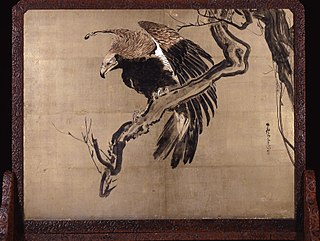
Nagasawa Rosetsu was a Japanese painter during the Edo period. A disciple of the Maruyama School, he was known for his versatile artistic style. He was born to the family of a low-ranking samurai. He studied with Maruyama Ōkyo in Kyoto.
Kerry James Marshall is an American artist and professor, known for his paintings of Black figures. He previously taught painting at the School of Art and Design at the University of Illinois at Chicago. In 2017, Marshall was included on the annual Time 100 list of the most influential people in the world. He was born and raised in Birmingham, Alabama, and moved in childhood to South Central Los Angeles. He has spent much of his career in Chicago, Illinois.

Kanō Sanraku was a Japanese painter also known as Kimura Heizō, Shūri, Mitsuyori, and Sanraku. He was the sixth-generation member of the famous Kanō family of painters that served the Japanese shoguns. Sanraku's works combine the forceful quality of Momoyama work with the tranquil depiction of nature, and they have a more refined use of color typical of the Edo period.
Tadashi Nakayama was a Japanese woodblock print artist, working in a style that combines influences from traditional Japanese ukiyo-e prints and Western painting.
Tang Da Wu is a Singaporean artist who works in a variety of media, including drawing, painting, sculpture, installation art and performance art. Educated at Birmingham Polytechnic and Goldsmiths' College, University of London, Tang gave his first solo exhibition, consisting of drawings and paintings, in 1970 at the Singapore Chinese Chamber of Commerce and Industry. He began engaging in performance art upon returning to Singapore in 1979 following his undergraduate studies.
Tiffany Chung is a Vietnamese American contemporary artist who works primarily in thematic cartography and installation, and is also active in photography, painting, performance, sculpture, and other arts. Chung is globally noted for her interdisciplinary and research-based practice, with works and installations that examine conflict, geopolitical partitioning, spatial transformation, environmental crisis, displacement, and forced migration, across time and terrain.
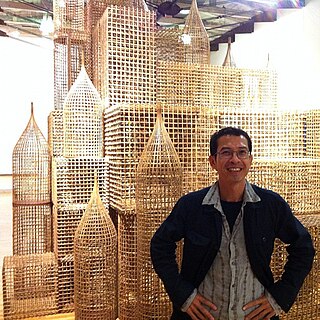
Sopheap Pich is a Cambodian American contemporary artist. His sculptures utilize traditional Cambodian materials, which reflect the history of the nation and the artist's relation to his identity.

Bamboo weaving is a form of bambooworking and a traditional Japanese craft, with a range of different applications, weaving styles and appearances. Japanese bamboo weaving is particularly well known for its use in basket weaving.
Sakaki Hyakusen, originally Shin'en (Japanese: 彭城 百川; was a Japanese painter in the nanga style. His other art names included Hōshū, Senkan and Hassendō.










